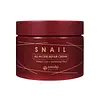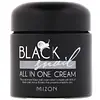What's inside
What's inside
 Key Ingredients
Key Ingredients

 Benefits
Benefits

 Concerns
Concerns

 Ingredients Side-by-side
Ingredients Side-by-side

Water
Skin ConditioningGlycerin
HumectantCaprylic/Capric Triglyceride
MaskingCetearyl Alcohol
EmollientButyrospermum Parkii Butter
Skin ConditioningDimethicone
EmollientNiacinamide
SmoothingPolyglyceryl-3 Dicitrate/Stearate
EmulsifyingPolysorbate 60
EmulsifyingPEG-100 Stearate
Glyceryl Stearate
EmollientCarbomer
Emulsion StabilisingSodium Polyacrylate
AbsorbentPotassium Hydroxide
BufferingAdenosine
Skin ConditioningDisodium EDTA
Butylene Glycol
HumectantSnail Secretion Filtrate 0.001%
Skin ConditioningPentylene Glycol
Skin ConditioningCaprylyl Glycol
Emollient1,2-Hexanediol
Skin ConditioningParfum
MaskingPhenoxyethanol
PreservativeChlorphenesin
AntimicrobialWater, Glycerin, Caprylic/Capric Triglyceride, Cetearyl Alcohol, Butyrospermum Parkii Butter, Dimethicone, Niacinamide, Polyglyceryl-3 Dicitrate/Stearate, Polysorbate 60, PEG-100 Stearate, Glyceryl Stearate, Carbomer, Sodium Polyacrylate, Potassium Hydroxide, Adenosine, Disodium EDTA, Butylene Glycol, Snail Secretion Filtrate 0.001%, Pentylene Glycol, Caprylyl Glycol, 1,2-Hexanediol, Parfum, Phenoxyethanol, Chlorphenesin
Snail Secretion Filtrate
Skin ConditioningNiacinamide
SmoothingHelianthus Annuus Seed Oil
EmollientCetearyl Olivate
Sorbitan Olivate
EmulsifyingButylene Glycol
HumectantSynthetic Wax
AbrasivePhenoxyethanol
PreservativeWater
Skin ConditioningEthylhexylglycerin
Skin ConditioningHydroxyethyl Acrylate/Sodium Acryloyldimethyl Taurate Copolymer
Emulsion StabilisingCarbomer
Emulsion StabilisingTriethanolamine
BufferingCaprylyl Glycol
EmollientSodium Polyacrylate
AbsorbentAdenosine
Skin ConditioningTropolone
Skin ConditioningCoptis Chinensis Root Extract
AntioxidantSorbitan Isostearate
EmulsifyingPolysorbate 60
EmulsifyingDisodium EDTA
Allantoin
Skin ConditioningPanthenol
Skin ConditioningGlycerin
HumectantTheobroma Cacao Extract
Skin ConditioningDextrin
AbsorbentTocopherol
Antioxidant1,2-Hexanediol
Skin ConditioningCentella Asiatica Extract
CleansingPalmitoyl Tripeptide-5
Skin ConditioningBeta-Glucan
Skin ConditioningCopper Tripeptide-1
Skin ConditioningSolanum Melongena Fruit Extract
Skin ConditioningCassia Obtusifolia Seed Extract
Skin ConditioningPorphyra Tenera Extract
Skin ConditioningFagus Sylvatica Seed Extract
Skin ConditioningDictyopteris Membranacea Extract
AntioxidantAllium Sativum Bulb Extract
Skin ConditioningPrunus Mume Fruit Extract
HumectantPolygonum Fagopyrum Seed Extract
Skin ConditioningRubus Coreanus Fruit Extract
Skin ConditioningMirabilis Jalapa Seed Extract
Skin ProtectingSepiolite
Charcoal Powder
AbrasiveAronia Melanocarpa Fruit Extract
Skin ConditioningEuterpe Oleracea Fruit Extract
Sambucus Nigra Fruit Extract
AstringentMorus Alba Fruit Extract
AntioxidantRhus Semialata Gall Extract
Skin ConditioningCinnamomum Cassia Bark Extract
MaskingInonotus Obliquus Extract
Skin ConditioningAnnona Cherimola Fruit Extract
Skin ConditioningCoffea Arabica Fruit Extract
AntioxidantVitis Vinifera Fruit Extract
Skin ConditioningCorthellus Shiitake Extract
Skin ProtectingPiper Nigrum Seed Extract
RefreshingSaccharum Officinarum Extract
MoisturisingRose Extract
Skin ConditioningSh-Oligopeptide-1
Skin ConditioningSnail Secretion Filtrate, Niacinamide, Helianthus Annuus Seed Oil, Cetearyl Olivate, Sorbitan Olivate, Butylene Glycol, Synthetic Wax, Phenoxyethanol, Water, Ethylhexylglycerin, Hydroxyethyl Acrylate/Sodium Acryloyldimethyl Taurate Copolymer, Carbomer, Triethanolamine, Caprylyl Glycol, Sodium Polyacrylate, Adenosine, Tropolone, Coptis Chinensis Root Extract, Sorbitan Isostearate, Polysorbate 60, Disodium EDTA, Allantoin, Panthenol, Glycerin, Theobroma Cacao Extract, Dextrin, Tocopherol, 1,2-Hexanediol, Centella Asiatica Extract, Palmitoyl Tripeptide-5, Beta-Glucan, Copper Tripeptide-1, Solanum Melongena Fruit Extract, Cassia Obtusifolia Seed Extract, Porphyra Tenera Extract, Fagus Sylvatica Seed Extract, Dictyopteris Membranacea Extract, Allium Sativum Bulb Extract, Prunus Mume Fruit Extract, Polygonum Fagopyrum Seed Extract, Rubus Coreanus Fruit Extract, Mirabilis Jalapa Seed Extract, Sepiolite, Charcoal Powder, Aronia Melanocarpa Fruit Extract, Euterpe Oleracea Fruit Extract, Sambucus Nigra Fruit Extract, Morus Alba Fruit Extract, Rhus Semialata Gall Extract, Cinnamomum Cassia Bark Extract, Inonotus Obliquus Extract, Annona Cherimola Fruit Extract, Coffea Arabica Fruit Extract, Vitis Vinifera Fruit Extract, Corthellus Shiitake Extract, Piper Nigrum Seed Extract, Saccharum Officinarum Extract, Rose Extract, Sh-Oligopeptide-1
Ingredients Explained
These ingredients are found in both products.
Ingredients higher up in an ingredient list are typically present in a larger amount.
1,2-Hexanediol is a synthetic liquid and another multi-functional powerhouse.
It is a:
- Humectant, drawing moisture into the skin
- Emollient, helping to soften skin
- Solvent, dispersing and stabilizing formulas
- Preservative booster, enhancing the antimicrobial activity of other preservatives
Adenosine is in every living organism. It is one of four components in nucleic acids that helps store our DNA.
Adenosine has many benefits when used. These benefits include hydrating the skin, smoothing skin, and reducing wrinkles. Once applied, adenosine increases collagen production. It also helps with improving firmness and tissue repair.
Studies have found adenosine may also help with wound healing.
In skincare products, Adenosine is usually derived from yeast.
Learn more about AdenosineButylene Glycol (or BG) is used within cosmetic products for a few different reasons:
Overall, Butylene Glycol is a safe and well-rounded ingredient that works well with other ingredients.
Though this ingredient works well with most skin types, some people with sensitive skin may experience a reaction such as allergic rashes, closed comedones, or itchiness.
Learn more about Butylene GlycolCaprylyl Glycol is a humectant and emollient, meaning it attracts and preserves moisture.
It is a common ingredient in many products, especially those designed to hydrate skin. The primary benefits are retaining moisture, skin softening, and promoting a healthy skin barrier.
Though Caprylyl Glycol is an alcohol derived from fatty acids, it is not the kind that can dry out skin.
This ingredient is also used as a preservative to extend the life of products. It has slight antimicrobial properties.
Learn more about Caprylyl GlycolCarbomer is a polymer of acrylic acid. Its main role is to create a gel consistency.
A high amount of carbomer can cause pilling or balling up of products. Don't worry, most products contain 1% or less of carbomer.
Disodium EDTA plays a role in making products more stable by aiding other preservatives.
It is a chelating agent, meaning it neutralizes metal ions that may be found in a product.
Disodium EDTA is a salt of edetic acid and is found to be safe in cosmetic ingredients.
Learn more about Disodium EDTAGlycerin is already naturally found in your skin. It helps moisturize and protect your skin.
A study from 2016 found glycerin to be more effective as a humectant than AHAs and hyaluronic acid.
As a humectant, it helps the skin stay hydrated by pulling moisture to your skin. The low molecular weight of glycerin allows it to pull moisture into the deeper layers of your skin.
Hydrated skin improves your skin barrier; Your skin barrier helps protect against irritants and bacteria.
Glycerin has also been found to have antimicrobial and antiviral properties. Due to these properties, glycerin is often used in wound and burn treatments.
In cosmetics, glycerin is usually derived from plants such as soybean or palm. However, it can also be sourced from animals, such as tallow or animal fat.
This ingredient is organic, colorless, odorless, and non-toxic.
Glycerin is the name for this ingredient in American English. British English uses Glycerol/Glycerine.
Learn more about GlycerinNiacinamide is a multitasking form of vitamin B3 that strengthens the skin barrier, reduces pores and dark spots, regulates oil, and improves signs of aging.
And the best part? It's gentle and well-tolerated by most skin types, including sensitive and reactive skin.
You might have heard of "niacin flush", or the reddening of skin that causes itchiness. Niacinamide has not been found to cause this.
In very rare cases, some individuals may not be able to tolerate niacinamide at all or experience an allergic reaction to it.
If you are experiencing flaking, irritation, and dryness with this ingredient, be sure to double check all your products as this ingredient can be found in all categories of skincare.
When incorporating niacinamide into your routine, look out for concentration amounts. Typically, 5% niacinamide provides benefits such as fading dark spots. However, if you have sensitive skin, it is better to begin with a smaller concentration.
When you apply niacinamide to your skin, your body converts it into nicotinamide adenine dinucleotide (NAD). NAD is an essential coenzyme that is already found in your cells as "fuel" and powers countless biological processes.
In your skin, NAD helps repair cell damage, produce new healthy cells, support collagen production, strengthen the skin barrier, and fight environmental stressors (like UV and pollution).
Our natural NAD levels start to decline with age, leading to slower skin repair, visible aging, and a weaker skin barrier. By providing your skin niacinamide, you're recharging your skin's NAD levels. This leads to stronger, healthier, and younger looking skin.
Another name for vitamin B3 is nicotinamide. This vitamin is water-soluble and our bodies don't store it. We obtain Vitamin B3 from either food or skincare. Meat, fish, wheat, yeast, and leafy greens contain vitamin B3.
The type of niacinamide used in skincare is synthetically created.
Learn more about NiacinamidePhenoxyethanol is a preservative that has germicide, antimicrobial, and aromatic properties. Studies show that phenoxyethanol can prevent microbial growth. By itself, it has a scent that is similar to that of a rose.
It's often used in formulations along with Caprylyl Glycol to preserve the shelf life of products.
Polysorbate 60 is used to help stabilize products. It is a surfactant and emulsifier. These properties help keep ingredients together in a product. Surfactants help reduce surface tension between ingredients with different states, such as liquids and solids. Emulsifiers help prevent oils and waters from separating.
Polysorbate 60 is sorbitol-based and created from the ethoxylation of sorbitan. Ethoxylation is a chemical reaction used to add ethylene oxide. Sorbitan is a the dehydrated version of sorbitol, a sugar found in fruits.
In this case, the 60 comes from reacting 60 units of ethylene oxide with sorbitan.
Polysorbates are commonly used in medicine and foods.
Learn more about Polysorbate 60Snail Secretion Filtrate is the excretion from snails. It is an effective moisturizer and promotes collagen production.
A popular nickname for this ingredient is 'Snail Mucin'.
Snail mucin has numerous skin benefits:
On top of this, Snail Secretion Filtrate contains a variety of vitamins and minerals. These include copper peptides, Vitamin A, and vitamin E. Vitamins A and E are antioxidants. Antioxidants help fight free-radicals that damage skin cells.
Being cruelty-free means a brand does not experiment on animals.
If you're worried about the well-being of the snails, we recommend looking more into the company of the product. Many brands have developed humane methods to collect snail mucin.
There is much debate on this subject. On one hand, this ingredient comes from an animal. On the other hand, many will argue the ingredient is naturally secreted (like a natural by-product) and therefore vegan. If you have reservations, you can look into Galactomyces Ferment Filtrate or Centella Asiatica Extract as alternatives.
Learn more about Snail Secretion FiltrateSodium Polyacrylate is the sodium salt of polyacrylic acid. It is used as an absorber, emollient, and stabilizer.
This ingredient is a super-absorbent polymer - meaning it can absorb 100 to 1000 times its mass in water. As an emollient, Sodium Polyacrylate helps soften and soothe skin. Emollients work by creating a barrier to trap moisture in. This helps keep your skin hydrated.
Water. It's the most common cosmetic ingredient of all. You'll usually see it at the top of ingredient lists, meaning that it makes up the largest part of the product.
So why is it so popular? Water most often acts as a solvent - this means that it helps dissolve other ingredients into the formulation.
You'll also recognize water as that liquid we all need to stay alive. If you see this, drink a glass of water. Stay hydrated!
Learn more about Water